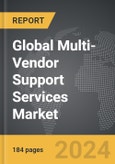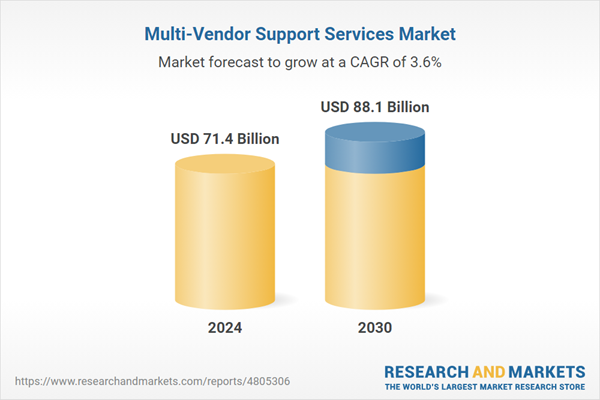The global market for Multi-Vendor Support Services was valued at US$71.4 Billion in 2024 and is projected to reach US$88.1 Billion by 2030, growing at a CAGR of 3.6% from 2024 to 2030. This comprehensive report provides an in-depth analysis of market trends, drivers, and forecasts, helping you make informed business decisions. The report includes the most recent global tariff developments and how they impact the Multi-Vendor Support Services market.
Segments: Offering (Hardware, Software); Organization Size (Large Enterprises, SMEs); Business Application (Supply Chain, Financial & Accounting, Human Resource, IT Operations, Other Business Applications).
Geographic Regions/Countries: World; United States; Canada; Japan; China; Europe (France; Germany; Italy; United Kingdom; and Rest of Europe); Asia-Pacific; Rest of World.
The analysts continuously track trade developments worldwide, drawing insights from leading global economists and over 200 industry and policy institutions, including think tanks, trade organizations, and national economic advisory bodies. This intelligence is integrated into forecasting models to provide timely, data-driven analysis of emerging risks and opportunities.
Global Multi-Vendor Support Services Market - Key Trends & Drivers Summarized
What Are Multi-Vendor Support Services and Why Are They Essential for Businesses?
Multi-vendor support services provide businesses with comprehensive technical and maintenance assistance for hardware and software systems sourced from different manufacturers. In today’s enterprise IT environments, businesses often rely on a diverse mix of technologies from multiple vendors to meet their operational needs. Managing and maintaining this complex infrastructure can be challenging, and multi-vendor support services streamline this process by offering a single point of contact for support across all systems. These services encompass troubleshooting, repair, performance monitoring, and upgrades, ensuring that all components of the IT infrastructure operate seamlessly together. Multi-vendor support services are particularly valuable for organizations looking to reduce complexity, improve operational efficiency, and ensure consistent performance across their entire technology stack.How Is Technology Driving the Evolution of Multi-Vendor Support Services?
The growing adoption of cloud computing, virtualization, and hybrid IT environments is driving the evolution of multi-vendor support services. As businesses shift to more complex IT architectures that integrate on-premises, cloud, and virtualized systems, managing and maintaining these environments becomes more complicated. Multi-vendor support services are increasingly incorporating automation and artificial intelligence to streamline the monitoring, troubleshooting, and optimization of multi-vendor environments. Predictive maintenance tools, powered by AI, are allowing service providers to anticipate potential issues before they arise, minimizing downtime and improving system performance. Additionally, the rise of remote monitoring and management tools is enabling more efficient, proactive support, allowing service providers to resolve issues without the need for on-site intervention.How Are Shifting Business Needs Shaping the Demand for Multi-Vendor Support?
As businesses become more reliant on technology to drive operations and deliver value to customers, the need for efficient IT infrastructure management is growing. Companies are increasingly opting for multi-vendor support services to simplify the management of their diverse technology portfolios, reduce costs, and ensure minimal disruption. The complexity of managing a multi-vendor environment often leads to operational inefficiencies and increased downtime when systems fail, so having a single service provider that can handle all support needs reduces these risks. Additionally, businesses are seeking to reduce vendor lock-in and increase flexibility by choosing support services that are independent of hardware and software providers. This shift toward greater vendor flexibility is fueling the demand for multi-vendor support services.What Are the Key Growth Drivers in the Multi-Vendor Support Services Market?
The growth in the multi-vendor support services market is driven by several factors, including the increasing complexity of IT environments, the rise of cloud computing, and the growing need for operational efficiency. As businesses adopt more hybrid and multi-cloud strategies, managing diverse IT systems across different vendors becomes more challenging, creating demand for comprehensive support services. The trend toward reducing vendor lock-in and seeking greater flexibility is also encouraging businesses to opt for third-party support providers that can manage multi-vendor environments. Furthermore, the growing reliance on AI-driven automation and predictive maintenance is enhancing the efficiency and value of multi-vendor support services, further driving market growth. The need for cost optimization in managing IT infrastructure, combined with the rapid pace of technological change, is also contributing to the increasing adoption of multi-vendor support services across industries.Report Scope
The report analyzes the Multi-Vendor Support Services market, presented in terms of units. The analysis covers the key segments and geographic regions outlined below.Segments: Offering (Hardware, Software); Organization Size (Large Enterprises, SMEs); Business Application (Supply Chain, Financial & Accounting, Human Resource, IT Operations, Other Business Applications).
Geographic Regions/Countries: World; United States; Canada; Japan; China; Europe (France; Germany; Italy; United Kingdom; and Rest of Europe); Asia-Pacific; Rest of World.
Key Insights:
- Market Growth: Understand the significant growth trajectory of the Hardware segment, which is expected to reach US$61.5 Billion by 2030 with a CAGR of a 3.8%. The Software segment is also set to grow at 3.1% CAGR over the analysis period.
- Regional Analysis: Gain insights into the U.S. market, valued at $19.4 Billion in 2024, and China, forecasted to grow at an impressive 3.4% CAGR to reach $14.1 Billion by 2030. Discover growth trends in other key regions, including Japan, Canada, Germany, and the Asia-Pacific.
Why You Should Buy This Report:
- Detailed Market Analysis: Access a thorough analysis of the Global Multi-Vendor Support Services Market, covering all major geographic regions and market segments.
- Competitive Insights: Get an overview of the competitive landscape, including the market presence of major players across different geographies.
- Future Trends and Drivers: Understand the key trends and drivers shaping the future of the Global Multi-Vendor Support Services Market.
- Actionable Insights: Benefit from actionable insights that can help you identify new revenue opportunities and make strategic business decisions.
Key Questions Answered:
- How is the Global Multi-Vendor Support Services Market expected to evolve by 2030?
- What are the main drivers and restraints affecting the market?
- Which market segments will grow the most over the forecast period?
- How will market shares for different regions and segments change by 2030?
- Who are the leading players in the market, and what are their prospects?
Report Features:
- Comprehensive Market Data: Independent analysis of annual sales and market forecasts in US$ Million from 2024 to 2030.
- In-Depth Regional Analysis: Detailed insights into key markets, including the U.S., China, Japan, Canada, Europe, Asia-Pacific, Latin America, Middle East, and Africa.
- Company Profiles: Coverage of players such as Abtech Technologies, CDS (Computer Data Source), Citrix Systems, Inc., Citycomp Service GmbH, Curvature, Inc. and more.
- Complimentary Updates: Receive free report updates for one year to keep you informed of the latest market developments.
Some of the 21 companies featured in this Multi-Vendor Support Services market report include:
- Abtech Technologies
- CDS (Computer Data Source)
- Citrix Systems, Inc.
- Citycomp Service GmbH
- Curvature, Inc.
- Dell EMC
- Ensure Services
- Evernex
- Fujitsu Ltd.
- Hewlett Packard Enterprise Development LP (HPE)
- Hitachi Ltd.
- IBM Corporation
- Lenovo Group Ltd.
- MCSA Group Ltd
- Microsoft Corporation
- NEC Corporation
- NetApp, Inc.
- OnX
- Oracle Corporation
- Park Place Technologies
- Service Express
- Symantec Corporation
- Terix Computer Service
- XS International, Inc.
- Zensar Technologies Ltd.
Tariff Impact Analysis: Key Insights for 2025
Global tariff negotiations across 180+ countries are reshaping supply chains, costs, and competitiveness. This report reflects the latest developments as of April 2025 and incorporates forward-looking insights into the market outlook.The analysts continuously track trade developments worldwide, drawing insights from leading global economists and over 200 industry and policy institutions, including think tanks, trade organizations, and national economic advisory bodies. This intelligence is integrated into forecasting models to provide timely, data-driven analysis of emerging risks and opportunities.
What’s Included in This Edition:
- Tariff-adjusted market forecasts by region and segment
- Analysis of cost and supply chain implications by sourcing and trade exposure
- Strategic insights into geographic shifts
Buyers receive a free July 2025 update with:
- Finalized tariff impacts and new trade agreement effects
- Updated projections reflecting global sourcing and cost shifts
- Expanded country-specific coverage across the industry
Table of Contents
I. METHODOLOGYII. EXECUTIVE SUMMARY2. FOCUS ON SELECT PLAYERSIII. MARKET ANALYSISIV. COMPETITION
1. MARKET OVERVIEW
3. MARKET TRENDS & DRIVERS
4. GLOBAL MARKET PERSPECTIVE
UNITED STATES
CANADA
JAPAN
CHINA
EUROPE
FRANCE
GERMANY
ITALY
UNITED KINGDOM
REST OF EUROPE
ASIA-PACIFIC
REST OF WORLD
Companies Mentioned (Partial List)
A selection of companies mentioned in this report includes, but is not limited to:
- Abtech Technologies
- CDS (Computer Data Source)
- Citrix Systems, Inc.
- Citycomp Service GmbH
- Curvature, Inc.
- Dell EMC
- Ensure Services
- Evernex
- Fujitsu Ltd.
- Hewlett Packard Enterprise Development LP (HPE)
- Hitachi Ltd.
- IBM Corporation
- Lenovo Group Ltd.
- MCSA Group Ltd
- Microsoft Corporation
- NEC Corporation
- NetApp, Inc.
- OnX
- Oracle Corporation
- Park Place Technologies
- Service Express
- Symantec Corporation
- Terix Computer Service
- XS International, Inc.
- Zensar Technologies Ltd.
Table Information
| Report Attribute | Details |
|---|---|
| No. of Pages | 184 |
| Published | April 2025 |
| Forecast Period | 2024 - 2030 |
| Estimated Market Value ( USD | $ 71.4 Billion |
| Forecasted Market Value ( USD | $ 88.1 Billion |
| Compound Annual Growth Rate | 3.6% |
| Regions Covered | Global |









